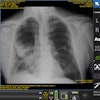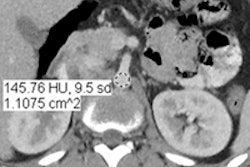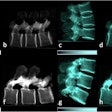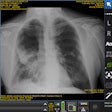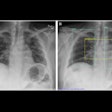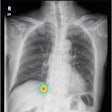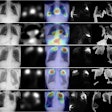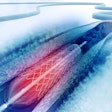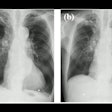
Researchers in the United Arab Emirates (UAE) are tracking radiation dose for interventional cardiology exams in children in order to optimize exposure. They found that levels are reasonable for the most common exams -- but they're mostly higher than the lowest published doses, according to a presentation at the 2014 Arab Health meeting.
 Dr. Fatima Al Kaabi from Tawam Hospital.
Dr. Fatima Al Kaabi from Tawam Hospital.Protecting children during medical imaging exams means knowing and monitoring interventional cardiac dose levels, according to the study team from Tawam Hospital in Al Ain. Dose area product (DAP) readings are particularly important because they are related to stochastic risk in children, i.e., the probability of developing a future cancer due to radiation exposure. Although the measured 2013 dose levels at the hospital were comparable to those in a few international studies, they typically exceeded the lowest published levels.
"Pediatric cardiology has been identified as one of the greatest contributors to radiation dose," said Dr. Fatima Al Kaabi in her talk. "And we know that children also have greater sensitivity to radiation than others ... with risks for cancer induction in children at two to three times the levels for adults."
However, there is surprisingly little published information on optimal pediatric interventional cardiology dose levels, even though such data are a critical first step on the path toward dose optimization, she said.
The current study sought to measure interventional dose levels at the hospital for exams during the last three months of 2013 for four common interventional pediatric cardiology exams:
- Balloon dilatation/stenting
- Occlusion of patent ductus arteriosus (PDA)
- Closure of atrial septal defect (ASD)
- Closure of ventricular septal defect (VSD)
Collecting data
Comprehensive data were gathered from each procedure, including the following:
- DAP readings in Gy-cm2
- Fluoroscopy time
- Patient data, including age, gender, weight, and height
- Cumulative air kerma (in mGy) and maximum skin entrance dose (in mGy)
- Acquisition series and frame rate
| Dose results of pediatric interventional procedures in 2013 | ||||
| Procedure type | Fluoro time (min) | DAP (Gy-cm2) | Cumulative air kerma (mGy) | Max. skin entrance dose (mGy) |
| Balloon dilatation/stenting | 31.6 | 30.0 | 366.5 | 384.3 |
| PDA | 15.8 | 9.2 | 180.7 | 107.3 |
| ASD | 12.0 | 7.8 | 78.3 | 51.0 |
| VSD | 33.6 | 15.6 | 159.5 | 94.7 |
Each reading has its own importance, Al Kaabi said. DAP is related to stochastic risk, and cumulative air kerma relates to the interventional reference point. The maximum skin entrance dose relates to the deterministic effects of radiation exposure, and it should be monitored to avoid tissue reactions.
The maximum skin entrance dose in the study was 384.3 mGy, signifying a low risk for skin injury, she said. The researchers also found a good correlation between patient weight and DAP (r = 0.742). In addition, air kerma measurements showed a downward trend over time: Cumulative air kerma was just under 600 mGy in 2011, just over 200 mGy in 2012, and approximately 300 mGy in 2013.
When compared with two previous studies covering these types of procedures, radiation results were generally comparable, according to Al Kaabi.
For example, Chida et al (American Journal of Roentgenology, November 2010, Vol. 195:5, pp. 1175-1179) published dose levels for interventional cardiac catheterization procedures in children. That group's mean fluoroscopy time was 24 minutes, compared with 31 minutes for Tawam Hospital, while DAP was about 17 Gy-cm2, compared with 25 Gy-cm2 for Tawam Hospital, she said.
Dose levels at Tawam were also higher than those reported in a study (Onnasch et al, BJR, March 2007, Vol. 80:951, pp. 177-185) for the International Atomic Energy Agency (IAEA), as indicated in the chart below.
| Mean DAP per unit of body mass | ||
| Procedure type | Onnasch et al | Al Kaabi et al |
| Balloon dilatation/stenting | 0.48 Gy-cm2 | 1.61 Gy-cm2 |
| PDA | 0.35 Gy-cm2 | 0.78 Gy-cm2 |
| ASD | 0.42 Gy-cm2 | 0.64 Gy-cm2 |
| VSD | 1.3 Gy-cm2 | 1.7 Gy-cm2 |
With this work completed, the study team will move on to optimizing dose levels based on the results, Al Kaabi said.
"Cardiologists should make every effort to reduce unnecessary radiation exposure from interventional cardiology procedures," she said, noting the particular importance of monitoring DAP to minimize the risk of future cancers in children with long lives ahead of them.
"Dose is the currency in which diagnostic information in x-ray imaging is paid for," Al Kaabi said, quoting the IAEA. "Optimization means getting a good deal."


